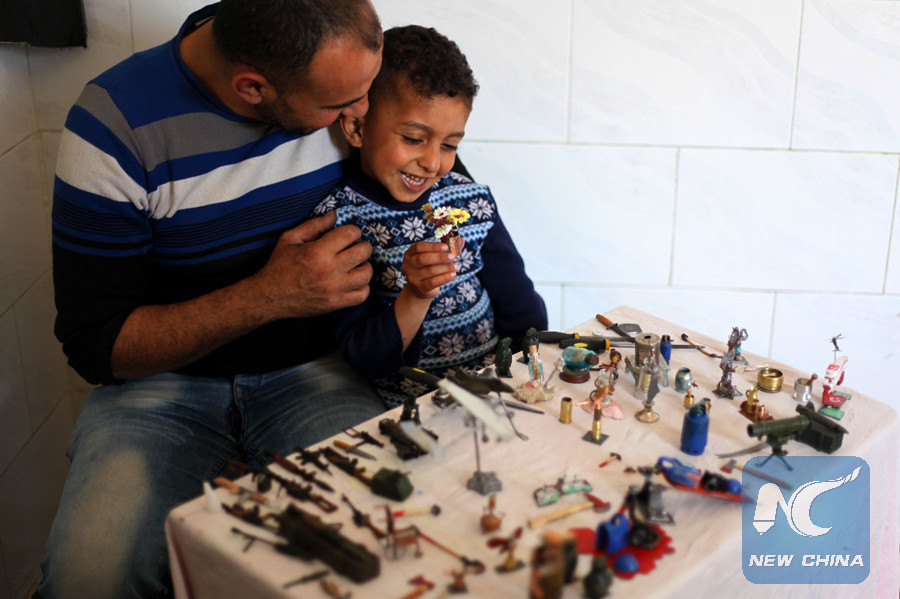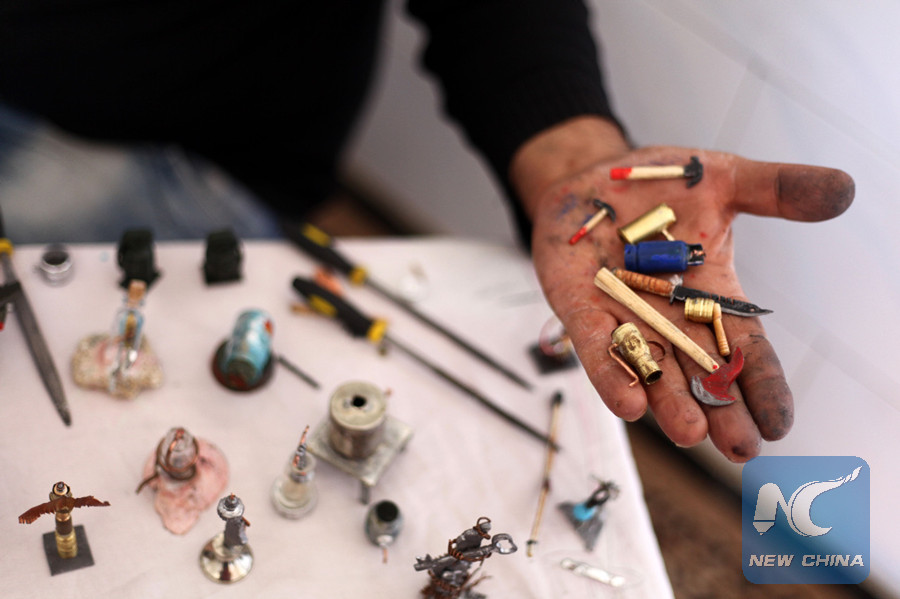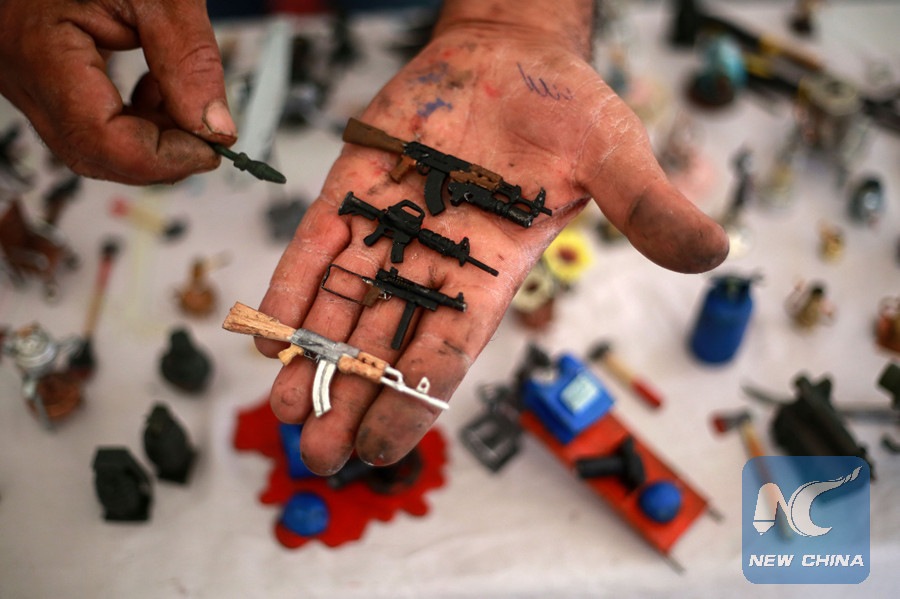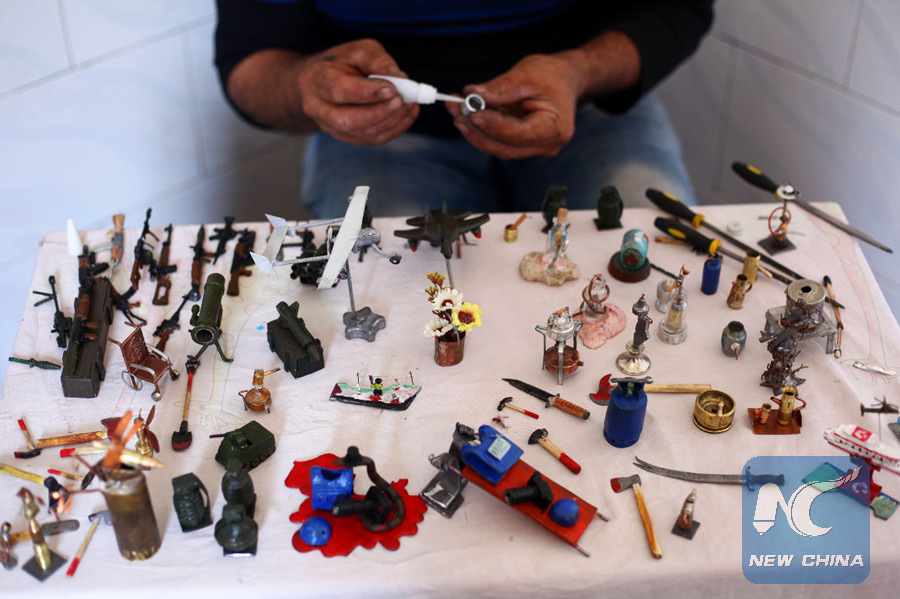
Palestinian artist Majdi Ab Taqyia, 38, and his son display a small antique inside their house in Nuseirat refugee camp, in central Gaza Strip, on April 29, 2018. (Xinhua/Stringer)
GAZA, May 1 (Xinhua) -- Majdi Ab Taqyia, a Palestinian from the Gaza Strip, turns gunshots and gas bombs fired by the Israeli army at Palestinian demonstrators into small pieces of art that impressed his visitors.
On a small table in a corner of his home in the Nussairat refugee camp in central Gaza Strip, Ab Taqyia showed his antiques after recycling firecrackers and gas bombs.
Ab Taqyia, in his 30s, has been collecting bullets and gas canisters from the eastern Gaza Strip near the borders with Israel, where popular Palestinian protests, known as "the Great March of Return," have been going on since March 30.

Palestinian artist Majdi Ab Taqyia, 38, displays small antiques inside his house in Nuseirat refugee camp, in central Gaza Strip, on April 29, 2018. (Xinhua/Stringer)
Ab Taqyia, a government employee who recently retired, began focusing on such art lately.
Before starting work, Ab Taqyia makes sure that the bullets he uses have no explosive materials to avoid danger.
"These pieces are very small, finger-sized or smaller," he said as he carved a small bullet to turn it into a masterpiece.

Palestinian artist Majdi Ab Taqyia, 38, displays small antiques inside his house in Nuseirat refugee camp, in central Gaza Strip, on April 29, 2018. (Xinhua/Stringer)
Ab Taqyia, lives in a rented house with his wife and three children, added that such art requires skill and accuracy.
"It comes out of your love for details," he said with joy.
The most difficult stage of making a piece is to think and imagine the perception of the piece and how it will look when it is fully completed, he said.

Palestinian artist Majdi Ab Taqyia, 38, displays small antiques inside his house in Nuseirat refugee camp, in central Gaza Strip, on April 29, 2018. (Xinhua/Stringer)
Ab Taqyia expressed hopes that his message will reach people all over the world to show Israel's use of bullets to suppress peaceful demonstrators.
"I am responding with another peaceful message through my art," he said.
Ab Taqyia's works mimic scenes from the return marches, such as the killing of Palestinian journalists Yasser Murtaja and Ahmed Abu Hussein.
He is also interested in the Palestinian heritage as he makes old teapot, or traditional Palestinian cooking tools.
Ab Taqyia, who is from a Palestinian refugee family, noted that he is keen to participate in the marches in support of the right of return of Palestinian refugees.
His wife, Walaa, uses free time to help him make artworks.
"I help my husband arrange, clean and paint some of his items," the 33-year-old woman said.
The man faces many challenges that prevent him from developing his art, the most important of which is the lack of equipment materials such as ceramic paste, lead metal and tools for carving and molding lead.
A few weeks ago, Ab Taqyia's brother was wounded by an Israeli bullet on the eastern border of the Gaza Strip during his participation in an anti-Israel protest.
"I took the remains of the bullet that the doctors had taken from my brother's feet and made a small figure in the form of an old Canaanite soldier," he told Xinhua.
Ab Taqyia dreams of making a complete work of the return camp on the Gaza-Israel borderline to illustrate the scenes of protesters, the barbed wire, journalists, children with throwing stones and Israeli soldiers firing teargas and explosive bullets at them.
Thousands of Palestinians participate in anti-Israel rallies that started on March 30 and are held in five areas along the borders with Israel.
Israel has reacted to the rallies with live fire and rubber-coated bullets, killing at least 44 people and injuring hundreds according to figures by the Palestinian Ministry of Health in Gaza.
The six-week protests are expected to peak on May 15, the day after the 70th anniversary of Israel's declaration of independence but marked by the Palestinians as the Nakba Day or "Day of the Catastrophe."

